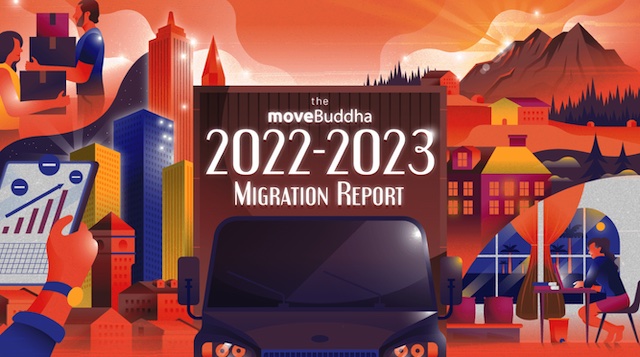“Nobody wants to be in a large, crowded city during a pandemic, but what about afterward? Don’t they miss bright lights? Theater? All-night diners?” asks MoveBuddha, a relocation service. “So far, the answer has been, ‘no.'” The company’s data show that net migration continues to be away from major cities and to small towns and exurban areas.
Click image to review this report.
The only cities over 250,000 that saw positive net in-migration actually prove the rule that people are leaving large, dense cities. Honolulu saw 2.19 in-migrants for every out-migrant, but the city of Honolulu covers the entire island of Oahu, of which only 37 percent is urbanized, so many of those in-migrants may have gone to rural parts of the city. The second-most was Anchorage at 2.17 in-migrants for every out-migrant, but, like Honolulu, Anchorage covers a huge area that is rural. In fact, less than 4 percent of the borough of Anchorage is considered urban. The only other two large cities that are gaining more in-migrants than out-migrants are Tulsa and Charlotte. At fewer than 2,000 people per square mile Tulsa is one the lowest-density big cities in the country (and also one of the most affordable), while Charlotte isn’t far behind at about 2,500 per square mile.
MoveBuddha also found that people are moving to mountain states such as Montana, Colorado, Tennessee, and North Carolina. Montana’s net in-migration isn’t as fast as it was a year ago, but this is a pattern familiar to native Montanans. At various times in recent history, people get inspired to move there but after experiencing a winter or two, they move away. Still, the overall pattern is that people are moving away from the more densely populated plains and into the less densely populated mountains.
Part of this movement is fueled by people working at home and part by the Great Resignation. At least 4 million Americans have quit their jobs per month in 17 of the last 19 months, says the Bureau of Labor Statistics. The data seem to show that the Great Resignation is tapering off, but employers who think so may be optimistic.
According to Fortune magazine, efforts by employers to force people to return to offices are not working very well. More than 75 percent of people working at home say they will quit their jobs if their employers try to force them to return to offices or other workplaces. Nearly half of all companies that have tried to enforce returns to work have seen higher than expected attrition rates, and close to 30 percent are having trouble recruiting replacements.
Urban planners who dream of convincing people to live in dense cities will be disappointed by these trends. Sadly, it is unlikely that they will stop trying to impose their utopian ideas on the public.









Germaphobia, Suburban paranoia and the laptop class who never leave their homes……
https://www.youtube.com/watch?v=Nofcrsk5Hx4
You mean turning our cities into Giant Parking lots isn’t vibrant or aesthetic…. who knew?
Toulouse, France:
https://i0.wp.com/themindcircle.com/wp-content/uploads/2023/01/cityscapes-then-vs-now-5.jpg
London: https://i0.wp.com/themindcircle.com/wp-content/uploads/2023/01/cityscapes-then-vs-now-6.jpg
Toronto: https://i0.wp.com/themindcircle.com/wp-content/uploads/2023/01/cityscapes-then-vs-now-8.jpg
Telluride, Colorado, USA: https://i.insider.com/5db07ec7045a31031b0f5ea2?width=1500&format=jpeg&auto=webp
Bath, Maine, USA: https://i.insider.com/5db6fcb4045a3177ce770778?width=1500&format=jpeg&auto=webp
Nantucket, Massachusetts, USA: https://i.insider.com/5db70150045a317aa84aea74?width=1500&format=jpeg&auto=webp
@LazyReader,
Downtown parking lots are criticized too often. It’s one of the few things actually keeping many downtowns alive. The alternative to a parking lot, in many cases, is simply a vacant lot.
The WFH research site is good for some actual data on WFH.
Their URL is : https://wfhresearch.com/
The latest report has WFH steady at 28% of paid hours worked.
It’s good to see some data on this issue. It’s surprising that more urban planners and transport planners are not going out to get more and better data on this.
WFH, along with the rise of small cheap electric vehicles and the probable coming of self-driving cars can really change where people live and how they transport themselves.
what if development on the parking lots became a modern day version of old milltowns in the south…plants would build housing for their employees. ie, 12 stories with corporate owned housing and ‘office oriented work’ combined.
Honolulu (city and county) may have net in migration, but the state does not.
“From July 2020 to July 2021, the state lost 10,358 residents, according to latest data from the U.S. Census Bureau.
In addition, Hawaii should have gained population because births outpaced deaths 15,510 to 11,279 during the period, creating what should have been a 4,231-person increase. This means about 14,500 people left the state in 2020-2021.
Combine that with losses from previous years, and, Bonham says, Hawaii has lost 30,000 residents.” Civil Beat 1/5/2022